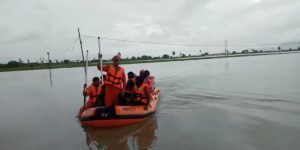After 20 years, Budameru turned furious as encroachments in Vijayawada choked it and blocked its destined route to the Kolleru Lake.
Published Sep 05, 2024 | 12:00 PM ⚊ Updated Sep 05, 2024 | 8:29 PM

Andhra Pradesh Chief Minister Chandrababu Naidu visiting the flood affected areas in Vijayawada. (X)
Budameru is to Vijayawada what Huang He — or the Yellow River — is to China. Last weekend, the rivulet lived up to its sobriquet, the Sorrow of Vijayawada.
The gentle rivulet normally warns Vijayawada residents before it strikes. It glides smoothly, caressing the northern part of Vijayawada, whenever its catchment areas receive enough rainfall. But on 31 August and 1 September, the creek took a savage form for the first time in 20 years.
Rivers reach their destinations, overcoming the obstacles on their way. As incessant torrential showers pounded Andhra Pradesh and Telangana over the weekend, the run-off water from the hillocks in the Krishna district and Khammam in the neighbouring Telugu state flowed into Budameru. And the creek turned furious, sending its muddy currents charging downstream.
The merciless waters invaded obstacles — mostly manmade — while rushing towards the destination, the Kolleru, Asia’s largest shallow lake, in the Eluru district. About 2.76 lakh people were affected when the brook found its way with a vengeance. For the first time since 2005, its waters invaded the city.
Budameru reclaimed its floodplains which have shrunk over the decades. It invaded lanes, inundating houses and other constructions that have come up in the plains. Several lives were lost as the stream flooded the encroached areas.
Originating from the hills of Mylavaram, Budameru traverses 176 kilometres before it empties into the Kolleru Lake. Several streams join it on the way. At Velagaleru near Vijayawada, a barrage with 11 locks impounds water if the flow is sluggish. Budameru’s catchment area is spread over 900 square kilometres, which is about 48 percent area of the former Krishna district.

NDRF personnel in Vijayawada. (Supplied)
The rivulet is not a tributary of the Krishna River, but a part of the Kolleru basin. Besides the encroachments on its floodplains, human greed has shrunk the Kolleru Lake as well, forcing water to occupy the space that originally belonged to it. Former chief minister of united Andhra Pradesh YS Rajasekhara Reddy tried to reclaim the encroached property but did not succeed.
The Budameru diversion channel, constructed in 2006-07, could not rise to the occasion this time. The channel was to take the Budameru flood into the 37,500-cusec-capacity Polavaram Right Canal which finally empties into the Krishna.
During the weekend gone by, Krishna itself was in spate, and its water level was higher than normal. The flow of water was more than 11 lakh cusecs. The Polavarm Right Canal could not debouch the Budameru waters, since the water level of the river was higher than that of the canal. It created a rebound effect as 50,000 cusecs of water flowed in with tremendous velocity.
Subsequently, the water level rose rapidly, breaching the bund at three places, and overflowing into residential colonies. Meanwhile, authorities opened all 11 locks of the Velagaleru barrage to manage the water level. However, the water that gushed out of the barrage flooded the colonies downstream. Most colonies were on Budameru’s floodplains.
The diversion canal at upstream of the barrage has a limited capacity of about 7,500 cusecs. It was designed to prevent flooding of the residential areas in the northern part of Vijayawada, mainly New Rajarajeswaripet, Nandamuri Nagar, Nunna, Payakapuram, Singh Nagar, Devi Nagar and others.
About 20 years ago, this part of the city was sparsely populated. It now has buzzing marketplaces and colonies. Most colonies came up on the floodplains.
While constructing the canal in 2006-2007 after the Budameru flood of 2005, the then government thought that it would be the insurance against floods. Little did the government know that Budameru posed a bigger threat to the city than anticipated. The canal’s capacity of 7,500 cusecs was woefully inadequate when about an estimated 30,000 to 35,000 cusecs of water flowed in during the weekend.
Irrigation expert and social activist Thunga Lakshminarayana attributed the floods to the encroachment of the Budameru’s floodplains, negligence in clearing the diversion canal of water hyacinths, and a pregnant Krishna River, which caused the water to rebound.
“Besides, several drains, including Muneru and Paleru, which were in spate joined the river in the upper reaches which increased the force of the water in the Krishna river that pushed Budameru water back into the Polavaram Right Main canal,” he said, adding that natural systems should be respected.
If the floodplains are encroached upon as in the northern part of Vijayawada, there would be disastrous consequences. Lakshminarayana advocated the need for effective steps to prevent further encroachments and relocation of the houses on the floodplains to clear the way for Budameru.
“This is the priority, and the government has to keep a watch on the officers who permitted constructions for gain,” he said.
Laskhminarayana said the present government should build a reservoir at Vainkuthapuram, upstream of the Prakasam barrage with a capacity to impound about 20 tmcft. It would reduce the risk of possible flooding.
A reservoir has already been planned as part of the linking of rivers and the government should immediately implement it to prevent floods.
Krishna floods are also a threat to habitations downstream. The Prakasam Barrage cannot impound more than three tmcft of water as it was never intended to be a reservoir.
He suggested that colonies vulnerable to Budameru floods should be protected by constructing an embankment like the one built to insulate Krishna Lanka in Vijayawada from Krishna floods.
“The same model could be replicated in areas facing the immediate threat of floods when Budameru is in spate,” Laskhminarayana added.
(Edited by Majnu Babu).
(South First is now on WhatsApp and Telegram)
